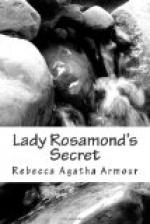Sir Howard had kept the troops at a respectable distance, where he could order them up at short notice; but he had no such intention. Imagine the surprise of both parties when a constable, having arrived, knocked down the flag and took Baker prisoner. Heavy imprecations fell upon such a course of conduct. Federal troops marched to the frontier, a circumstance of which the colonists took no notice. Sir Howard took further steps; he ordered the prisoner to be brought to trial before the Supreme Court at Fredericton, where he was found guilty, with sentence of a heavy fine.
Threatening attitudes were assumed by the leaders of this dispute, but to these Sir Howard paid not the least attention. Messages were sent by Governor Lincoln with urgent demands for Baker’s release without any effect. They had to treat with one whose character was marked by firm determination. An American officer was also sent urging the necessity of the release of the prisoner. He was not granted an interview, but was kindly cared for in the mess-room of the 81st, where the officers gave him a hearty reception by a grand dinner, ordered expressly for the occasion. Despite the swaggering and menacing tone of this guest, the evening was spent in successive rounds of mirth and exciting gaiety. Songs, toasts and speeches greeted the ears of the envoy, and amidst these he almost forgot the object of his mission. At last the fine was paid. It was not until the matter was finally settled, by the decision of the king of the Netherlands, that comparative peace was restored.
This chapter now ends, having described the principal events that marked the year 1827.
CHAPTER XIII.
CHESLEY MANOR—MARRIAGE OF LADY ROSAMOND.
We are again introduced to Lady Rosamond, now reinstated in the home of her childhood. A sense of gratitude is awakened within her as she fondly gazes upon the old familiar scenes surrounding Chesley Manor. The quaint old structure was an exact specimen of an English manor house in the early part of the seventeenth century, having been designed by an architect of the royal household in the reign of James the First, whence it still continued in the possession of its illustrious descendants.
The style adapted to the above named structure was more strictly domestic than defensive. It was built in quadrangular form, containing only one large court, upon which opened the stately hall, chapel, and principal apartments. Though not commanding the imposing aspect and grandeur of Bereford Castle, Chesley Manor had an air of true gentility in keeping with that of its owner. Lofty windows, reaching to the ground, looked out upon the gardens, which were enclosed by a high wall.
The period in which the present edifice was constructed was that of the best style of English architecture, contrasting the more elegant and graceful manor house with the frowning keep and embattled walls of the olden castle.




